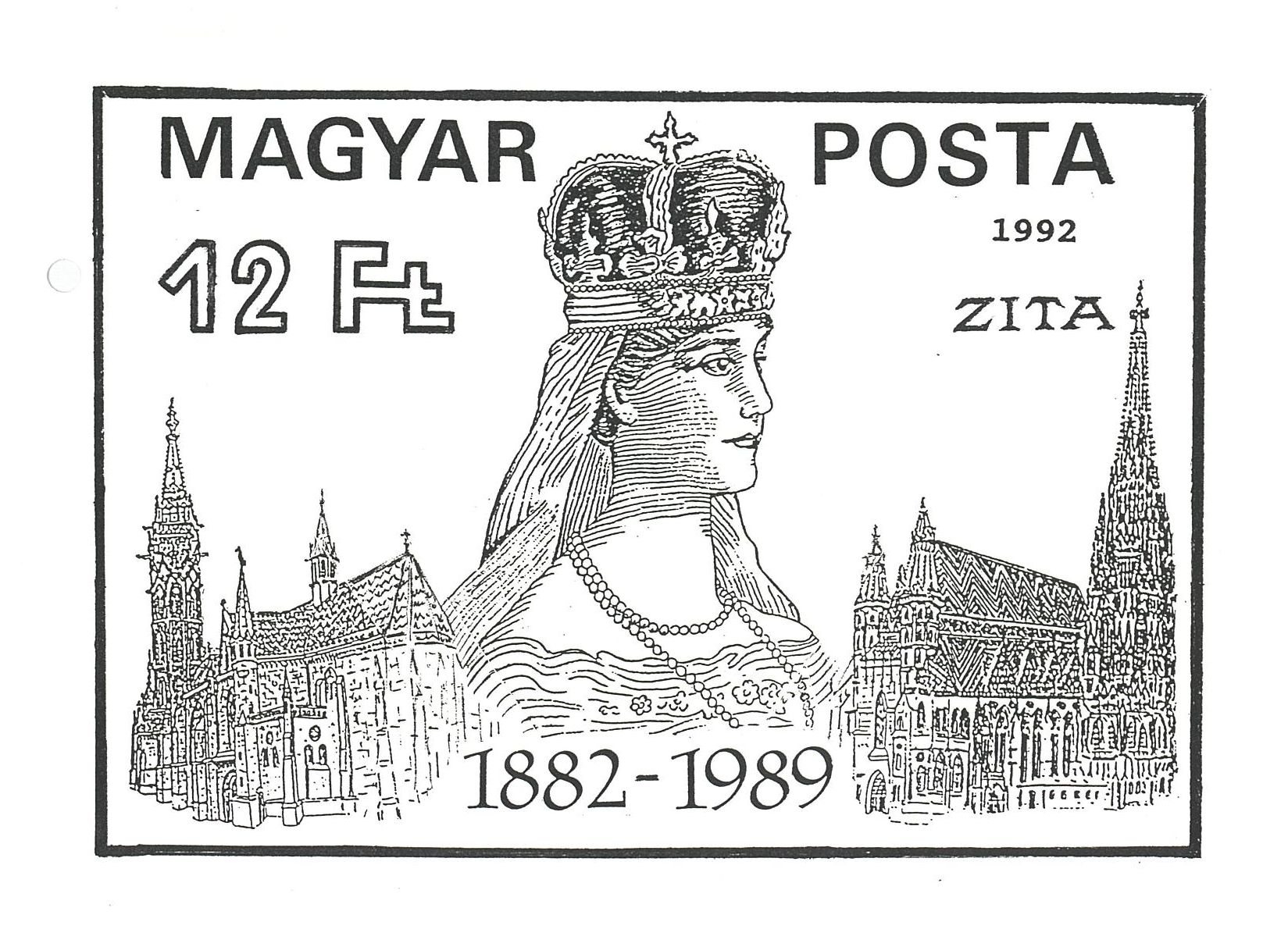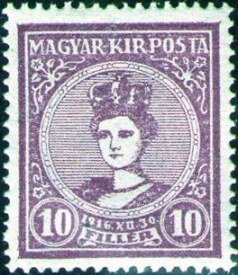In 1989 the painter Kornél Hideg made an offer to Otto von Habsburg to design a commemorative stamp on the 100th anniversary of the birth of Queen Zita (1892–1989). After the failure of his proposal in Austria, he tried to implement his plan at the Hungarian government and at the Hungarian Post Office as well, but it became clear that the time had not yet come to adopt such an idea. Otto von Habsburg supported the issuance of the stamp, but this proved to be little at the time. The stamp, depicting the royal couple, was designed only a decade and a half later, in 2016, on the occasion of the 100th anniversary of the coronation.
Queen Zita, the widow of King Charles IV died on March 14, 1989, at the age of 97. An imperial funeral in accordance with the traditions of the Habsburg House was held in Vienna, and a commemoration and mourning mass took place in Budapest. The ceremonies in Vienna and Budapest once again shed light on the life and activities of the last great witness of a bygone world empire. The two capitals tried to give everything to the former empress and queen – who never lost her pride, wore solely black after her husband’s death, who lived in retreat and primarily for her eight children – at least after her death.
On December 30, 1916, when Archduke Charles ascended the throne, everyone looked forward with great anticipation to the reign of the young king and queen. A visible expression of this was that the young couple received a number of greeting cards, congratulatory letters, telegrams, gifts and poems, and several expressed their need for Zita to take the place of Queen Elizabeth. Not only private individuals, but also Prime Minister Count István Tisza contributed to the commemoration of the coronation, as he addressed King Charles IV, asking for stamps to be issued with the portrait of the royal couple. He argued that he was fulfilling a “public demand” because “it is common in all cultural states to issue special postage stamps, so-called commemorative stamps, for major events for a specified period of time.”
Depicting Queen Zita, lithographic 10-cent coronation stamp (December 30, 1916)
On December 15, 1916, King Charles IV consented to the issuance of the stamps, which were first issued on December 30, 1916, the day of the coronation, and expired on December 31, 1917. The stamps with the double cross watermark were issued in 1,100,000 copies produced by the State Printing House. The stamp depicting King Charles IV was pink, the stamp of Zita was violet. The stamps that appeared in the coronation series were issued in denominations of 10 and 15 pennies. More than a year and a half later, in memory of the coronation, on August 30, 1918, a portrait of Zita designed by Imre Földes was published. Stamps issued in denominations of 10, 15, 20, 25, 40 and 50 pennies were sold by mail order between 30 August 1918 and 23 November 1918. The above stamps were just put on the market when the Aster Revolution broke out and the people’s republic was proclaimed. At that time, all the stamps in circulation were overprinted with a black “Republic” sign, including the 40- and 50-penny stamps depicting the Queen. These three stamps were issued for Queen Zita. An attempt was made to put another stamp on the market in 1933, when an aluminium imprint was made of the coronation stamps of King Charles IV and Queen Zita. A negative image of two stamps was visible on the aluminium plate. This stamp was designed by the post office, but was not issued eventually.
Stamps with the inscription “Republic” (1918)
The events following the coronation, the loss of World War I, the disintegration of the Austro-Hungarian Monarchy, the deprivation of the Habsburgs of Austria, the emigration of the family, and then King Charles’s unsuccessful attempts to regain the Hungarian throne contributed greatly to the fact that Zita and the ruling family were forgotten by Hungary for a long time, and their memory was obscured by oblivion. Half a century later, the perception of the Habsburg family changed significantly and was re-evaluated, mainly due to Otto von Habsburg’s activities in international political and social life. The consequence of this was the large-scale and spectacular burial of Queen Zita and the echo of the event, which moved the imagination of some royal artists who offered their service out of individual loyalty to or out of respect for the royal family. One such loyal painter was Kornél Hideg, who lived in Austria and planned to issue a commemorative stamp about Queen Zita. The design of the commemorative stamp was inspired by Queen Zita’s death and the upcoming 100th anniversary of her birth.
We have little information about the painter Kornél Hideg. The painter from Nagyharsány, Baranya County, settled in Austria. He organized an exhibition in Hungary, for example in Nagycenk, and donated thirty of his works to the Széchenyi Memorial Museum. He considered it his quest to explore the fate of Hungarian writers connected to Vienna, for which he also conducted archival research. He wrote the story of the battle that took place in Nagyharsány on August 12, 1687. In 1991, he gave a presentation at a conference for the physically handicapped. In a letter to Otto von Habsburg in 1992, he referred to his past, his patriotism, his double attachment to Miklós Horthy and the Habsburg family. In his view, “respect for these two ruling families cannot be considered contradictory.”
Kornél Hideg’s intention to design the commemorative stamp was in his view a debt to Queen Zita’s eldest son, “His Majesty Otto”, and on April 26, 1989, he made an offer to Otto von Habsburg to create the stamp. In a letter dated 8 May 1989 written to Otto von Habsburg’s secretary, Erzsébet Gelsey, he proposed a meeting with a Zita expert, Professor Erich Feigl, for which meeting he also wanted to prepare sketches. He then contacted the post office with more detailed plans and then consulted with Erzsébet Gelsey on several occasions because “the Baroness’s expertise in the fine arts is great”. He asked the Baroness to keep Otto von Habsburg informed of the developments as well. In a letter to Erzsébet Gelsey dated 2 January 1990, he had already indicated that, according to official information it was not possible to issue the stamp for the 100th anniversary. He remarked that “this news was not overwhelming to him” primarily because he was confident in the positive change. In the remainder of his letter, he wrote about his difficulties, the obstacles that arose, the lack of adequate support, and the rejection of museums. According to a critical response letter sent by the Secretariat ten days later, “small-calibre officials decide whose imagination is too small for such a plan”. Erzsébet Gelsey encouraged not to give up hope, because what cannot be solved in Austria might be easier to realize in Hungary. After that, there was a longer pause in the correspondence.
The yarn was picked up again in 1991, when Kornél Hideg gave good news to the Secretariat in a letter dated 21 March. Namely, that the officials of the Hungarian Post informed him about the review of his stamp issuance proposal and blueprints, which they thanked, and then informed him that a committee would decide on the issuance of the 1992 stamps. In the secretary’s reply four days later, we also read Otto von Habsburg’s thoughts that “the most beautiful stamp that appeared on his mother was at the time of the coronation.” He asked the artist to base the design on this stamp. For help, on April 16, the Secretariat sent stamps issued in 1918 about Queen Zita. According to the description of the stamp catalogue, three stamps were issued about Zita. In a letter a week later, Kornél Hideg thanked for the stamps sent, the trust, the “honour,” and the patronage with which Otto von Habsburg handled the making of the commemorative stamp.
Kornél Hideg made his stamp design in two versions. One was divided into three parts, the other without it. At the centre of both stamps was the crowned Queen Zita, whose year of birth and death was also written on the stamp. On the right side of the stamp design was the Matthias Church in Buda, while on the left the Stephanskirche in Vienna. The divided stamp was designed for 4 forints, the non-divided stamp for 12 forints. He indicated the year 1992 on the stamps, and then sent the completed stamp design to Otto von Habsburg, who liked the draft.
The three-year correspondence took an unexpected turn when the Hungarian Post officially rejected its graphic design. Kornél Hideg reported on the rejection in a short letter dated 27 December 1991, in response to which Erzsébet Gelsey expressed her regret and stated that “his work was not in vain”, as she drew the attention of the authorities to this important date. For a long time, the case was marked by a series of delays and vague promises. With the rejection, it might have seemed that the matter of the stamp design has fallen silent. However, Kornél Hideg did not give up the fight, even “if the impedimental conditions continued”.
On June 21, 1992, he wrote another letter to Otto von Habsburg, again informing him of the status of the case. In his letter, he reported not only on the rejection, but also on his inability to accept the decision. He wrote to three official bodies: in a submission to the Director of Hungarian Post Office on July 28, 1992, he indicated that Queen Zita’s commemorative stamp had not been issued, which is incomprehensible to him. He considered it important to commemorate the leaders who worked to turn people’s destinies to the better so that they would not “disappear without a trace”. The 105th anniversary of the birth of King Charles and the 100th anniversary of the birth of Queen Zita was such an event. He called on the Director: “It is still not too late to review whether the commemorative stamp should be issued.” His response was still a firm rejection.
On August 2, 1992, he sent two letters to the government spokesman of the Office of the Prime Minister of the Republic of Hungary. He argued that “the Habsburg family’s presence in Hungary has a much greater history than simply being forgotten”. In a third letter, he addressed the Prime Minister’s Press Office on 8 September 1992. The Press Office read with “interest and touch” “the writing of a man driven by real, noble, patriotic feelings,” but he received no substantive response here either. Finally, as an attachment to his Christmas greetings, Hideg sent these three letters to Otto von Habsburg. He responded to the letter. In his view, it should be noted that “for us, many things still do not always work as we would expect, which is understandable, however, since after forty years of destruction it is not possible to restore the country overnight.” However, ideas like Hideg’s contribute to getting people to know their tradition. The exchange of letters between Kornél Hideg and Otto von Habsburg did not end with a stamp issue planned for the 100th anniversary of the birth of Queen Zita. The graphic artist later reported on his further plans, such as organizing a planned village museum in his native town, Nagyharsány or publishing his study of the Battle of Nagyharsány. After that, however, the correspondence between them ceased.
Benedek Imre: On the occasion of the 100th anniversary of the coronation of late IV. King Charles and Queen Zita issued special stamp block (August 17, 2016)
The documents in the Otto von Habsburg Collection did not reveal the real reason for the rejection of the draft stamp. This may have been related to the fact that the official bodies did not yet tolerate or take into account individual ideas in the initial period of the regime change, and the Post Office had its own idea of its stamp issuance plans. However, the 100th anniversary of the coronation of King Charles and Queen Zita was not forgotten by grateful posterity. In 2016, Hungarian Post issued an occasional stamp block to commemorate the event. The serial numbered stamp block containing three stamp images was made in a special edition decorated with silver foil and embossing, based on the plans of graphic artist Imre Benedek. Kornél Hideg’s idea of commemorating Queen Zita came true, even if it was not him, who did it.
Piroska Kocsis





